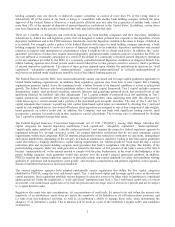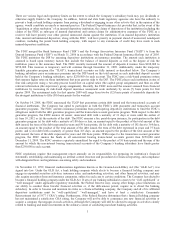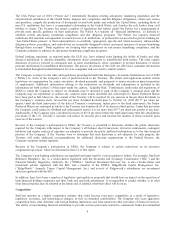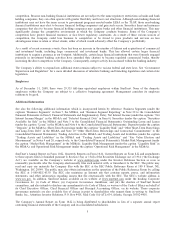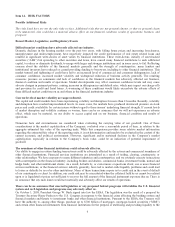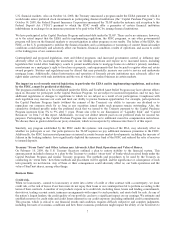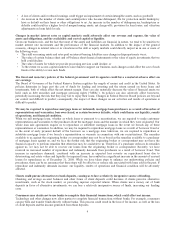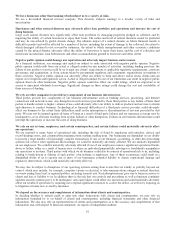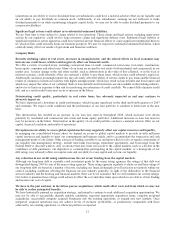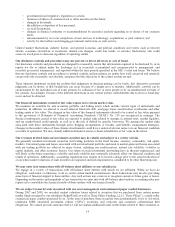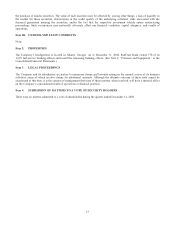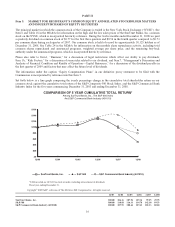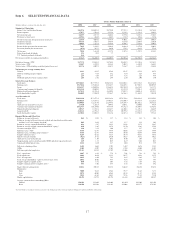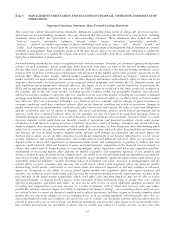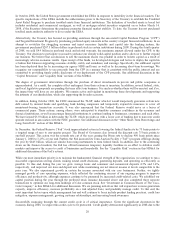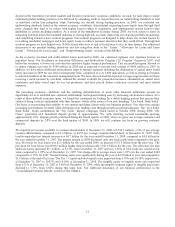SunTrust 2008 Annual Report Download - page 24
Download and view the complete annual report
Please find page 24 of the 2008 SunTrust annual report below. You can navigate through the pages in the report by either clicking on the pages listed below, or by using the keyword search tool below to find specific information within the annual report.Limitations on our ability to receive dividends from our subsidiaries could have a material adverse effect on our liquidity and
on our ability to pay dividends on common stock. Additionally, if our subsidiaries’ earnings are not sufficient to make
dividend payments to us while maintaining adequate capital levels, we may not be able to make dividend payments to our
common stockholders.
Significant legal actions could subject us to substantial uninsured liabilities.
We are from time to time subject to claims related to our operations. These claims and legal actions, including supervisory
actions by our regulators, could involve large monetary claims and significant defense costs. Substantial legal liability or
significant regulatory action against us could have material adverse financial effects or cause significant reputational harm to
us, which in turn could seriously harm our business prospects. We may be exposed to substantial uninsured liabilities, which
could adversely affect our results of operations and financial condition.
Company Risks
Recently declining values of real estate, increases in unemployment, and the related effects on local economies may
increase our credit losses, which would negatively affect our financial results.
We offer a variety of secured loans, including commercial lines of credit, commercial term loans, real estate, construction,
home equity, consumer and other loans. Many of our loans are secured by real estate (both residential and commercial) in our
market area. A major change in the real estate market, such as deterioration in the value of this collateral, or in the local or
national economy, could adversely affect our customer’s ability to pay these loans, which in turn could adversely impact us.
Additionally, increases in unemployment also may adversely affect the ability of certain clients to pay loans and the financial
results of commercial clients in localities with higher unemployment, which may result in loan defaults and foreclosures and
which may impair the value of our collateral. Risk of loan defaults and foreclosures are unavoidable in the banking industry,
and we try to limit our exposure to this risk by monitoring our extensions of credit carefully. We cannot fully eliminate credit
risk, and as a result credit losses may occur or increase in the future.
Deteriorating credit quality, particularly in real estate loans, has adversely impacted us and may continue to
adversely impact us.
We have experienced a downturn in credit performance, which became significant in the third and fourth quarters of 2007
and continues. We expect credit conditions and the performance of our loan portfolio to continue to deteriorate in the near
term.
This deterioration has resulted in an increase in our loan loss reserves throughout 2008, which increases were driven
primarily by residential and commercial real estate and home equity portfolios. Additional increases in loan loss reserves
may be necessary in the future. Deterioration in the quality of our credit portfolio can have a material adverse effect on our
capital, financial condition, and results of operations.
Disruptions in our ability to access global capital markets may negatively affect our capital resources and liquidity.
In managing our consolidated balance sheet, we depend on access to global capital markets to provide us with sufficient
capital resources and liquidity to meet our commitments and business needs, and to accommodate the transaction and cash
management needs of our clients. Other sources of funding available to us, and upon which we rely as regular components of
our liquidity risk management strategy, include inter-bank borrowings, repurchase agreements, and borrowings from the
Federal Reserve discount window. Any occurrence that may limit our access to the capital markets, such as a decline in the
confidence of debt purchasers, our depositors or counterparties participating in the capital markets, or a downgrade of our
debt rating, may adversely affect our capital costs and our ability to raise capital and, in turn, our liquidity.
Any reduction in our credit rating could increase the cost of our funding from the capital markets.
Although our long-term debt is currently rated investment grade by the major rating agencies, the ratings of that debt was
downgraded during 2009 by one of the major rating agencies. These rating agencies regularly evaluate us and their ratings of
our long-term debt are based on a number of factors, including our financial strength as well as factors not entirely within our
control, including conditions affecting the financial services industry generally. In light of the difficulties in the financial
services industry and the housing and financial markets, there can be no assurance that we will maintain our current ratings.
Our failure to maintain those ratings could adversely affect the cost and other terms upon which we are able to obtain funding
and increase our cost of capital.
We have in the past and may in the future pursue acquisitions, which could affect costs and from which we may not
be able to realize anticipated benefits.
We have historically pursued an acquisition strategy, and intend to continue to seek additional acquisition opportunities. We
may not be able to successfully identify suitable candidates, negotiate appropriate acquisition terms, complete proposed
acquisitions, successfully integrate acquired businesses into the existing operations, or expand into new markets. Once
integrated, acquired operations may not achieve levels of revenues, profitability, or productivity comparable with those
achieved by our existing operations, or otherwise perform as expected.
12


